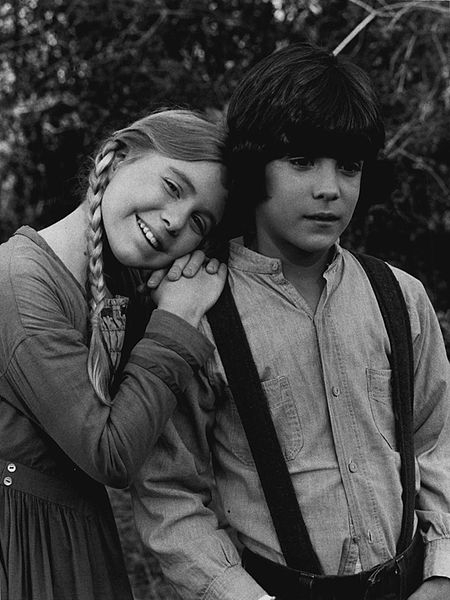You have /5 articles left.
Sign up for a free account or log in.

"Little House on the Prairie"
Wikimedia Commons
NEW YORK – Kathleen Casey, an assistant professor of history at Virginia Wesleyan College, thought teaching a course on the history of American leisure time – what she called a “history of fun” – would be a good way to reach non-majors and other students who weren’t particularly enthusiastic about history.
Her colleagues warned her that billing a course as the history of fun might attract students who didn’t just dislike history classes, but who disliked classes in general. Casey considered their concerns but largely ignored them. After all, she said, this wasn’t her first general education history course, and the risk was worth the reward: converting a group of students who thought history was limited to “epic battles between great white men.”
The class – a non-comprehensive, mostly chronological look at Americans’ pursuit of pleasure, including through drinking, dancing, sport and other kinds of recreation and their related politics – would be the “perfect vehicle” for confronting preconceived notions about history, she thought.
Turns out Casey’s colleagues were right, starting from the first day of the semester. That’s when a student stood up, bowed, and unceremoniously climbed over several desks to leave the room upon hearing that he would be required to read five books -- inconsistent, he apparently thought, in a course purportedly about fun. Similar events peppered the rest of Casey’s semester – a student athlete turned in an essay exam after 15 minutes because he’d scheduled a meeting with his trainer, for example – and, in the end, the class failure rate was higher than any Casey had had before, or since.
“I was wrong in thinking that this would be relatively easy,” Casey said.
So go the challenges of making history “popular,” which was the topic of a session here Friday at the annual meeting of the American Historical Association. With calls from deans and chairs to promote greater enrollment in history courses, and a greater focus among historians on interdisciplinarity – indeed, “History and the Other Disciplines” is the theme of this year’s AHA conference – history professors are increasingly incorporating elements of popular culture into their classes.
And while that can offer rewards, in the form of more media-literate students with a wider sense of what history is, it’s also perilous, Casey and other panelists said. Some students view “popular” and fun as incompatible with rigor or the hard work professors expect from them. And some students also resent having their ideas or fantasies about certain historical periods or figures challenged, speakers said.
But a failed course can be a learning opportunity for a professor, as it turned out to be for Casey. She waited three semesters before offering the course again – this time as an honors class. She said she admitted that doing so was a bit like “cheating,” but she also changed other key elements of the course. She included explicit warnings about her expectations for hard work and attendance – no late papers accepted under any circumstances, for example – in her syllabus, along with a trigger warning about depictions of violence in some units.
Casey didn’t leave out all the fun, though, saying she still wanted students to want to take her course. So she still fostered class discussions about the parallels between what students were studying and their everyday lives – historical precedents for the “man cave,” for example – and asked the class to participate in such “embarrassing” activities as singing “Take Me Out to the Ballgame” during class or learning the once-scandalous ragtime “animal dances.”
Thanks to these and other tweaks, the second round was vastly improved, Casey said. Students learned empathy for different viewpoints and the power of play in everyone’s lives, from young to old, native to immigrant, she said. Most importantly, they also learned that history “is not about or not just about extraordinary people in epic events.” Casey also said the class has encouraged her to incorporate more popular history into her other, more traditional courses.
Malgorzata J. Rymsza-Pawlowska, an American studies scholar who is an assistant professor of history at Eastern Illinois University, said she wants students to see that “history is alive” and constructed – not a set of objective facts, as many undergraduates assume. It’s a challenging task, she said, noting that many non-major students enter her classes not knowing what a primary source document is. She also noted the historian’s impulse to dispense with such popular sources as the History Channel. But she warned that popular culture is the “site where history is made,” and said she’d had success incorporating many elements of popular history into her required general education survey of American history since 1877.
Rymsza-Pawlowska said she prepares her students for her somewhat unconventional approach by discussing two things at the beginning of that class: Raymond Williams’s concept of the “structures of feeling” among people in particular times and places, and “Something New Starts Every Day,” an 1830s song about the Industrial Revolution. She asks students to make connections between the two texts and consider the idea that cultural artifacts are symptomatic of their historical periods.
Along with historical readings, Rymsza-Pawlowska incorporates post-1877 social artifacts found through the Library of Congress, YouTube and even eBay. She does some light training in multimodal literacy, so that students can navigate the internet productively as scholars. But she focuses on the notion that “inside or outside the classroom, we are always doing history,” and teaches students the critical analysis skills to interpret what they find. She encourages rigorous analysis and comparison of the “abundance of evidences” available to someone studying post-1877 history, she said – sometimes multiple times for the same text.
One such example is the Little House on the Prairie series. Rymsza-Pawlowska first teaches the books by Laura Ingalls Wilder to depict the onslaught of challenges facing pioneers in the American West. Then she considers them again during her discussion of the Great Depression, during which the books were written. Last, she shows students portions of the 1970s-era television show based on the books, which reflected many contemporary concerns, such as post-traumatic stress among Vietnam War veterans, through episodes about the challenges facing Civil War veterans. Looking at even one text at multiple points throughout history drives home the “core values” of the course, Rymsza-Pawlowska said.
“I want my students to recognize that history is all around,” she said, and to “use the past to think about the present.”
Speakers said that challenges remain even when they achieve those goals, however. Some students have romantic ideas about the “roaring” 1920s, for example, that are challenged or – in students’ words, “ruined” – by the realization that the decade wasn’t just the Jazz Age, but also an era of growing social conservatism. Sometimes students also object to presentations of great social leaders showing they led unethical personal lives, for example, other speakers said.
Charles Baraw, an assistant professor of English at Southern Connecticut State University who teaches a course on historical graphic novels, including Art Spiegelman’s Maus, about the Holocaust, and Mat Johnson’s Incognegro, about 1930s race relations, asked fellow panelists and audience members for help in that vein. He said that while teaching students about the narrative power of history through graphic novels undoubtedly makes them more “confident” about the “complexity of history,” it also shakes some of them. He said he wanted to know what to tell “literal-minded” students about how to reflect on how history is made when they feel like “nothing is valid anymore.”
Casey said she wondered if learning about history through popular history meant a kind of “growing up,” in that there was a fine line between educating and “ruining.” Rymsza-Pawlowska wondered if students were not only responding to their perceptions about history being challenged, but also their modes of engagement. In Baraw’s example, she said maybe students were upset that they could no longer passively read comics without analyzing them – not necessarily a bad thing.
She added: “What I would say is no one ever holds this so-called high culture to the standard. You’re supposed to engage meaningfully and deeply with the arts. But why can't you do that with comics?”
One audience members pointed out that professors aren’t always the best judges of how successful a foray into popular culture is. Matthew Joseph, a graduate student in history at Columbia University, said he was inspired to pursue a career in popular music history after taking a course on funk music as an undergraduate at Yale University. Joseph said he was surprised to hear later than the professor had considered the course an “abject failure” that students found to be “too hard,” and hadn’t taught it since.
Another audience member asked about the administrative repercussions, if any, about taking experimenting with popular culture in history courses. Rymsza-Pawlowska said that, on the contrary, she thought her administrators liked the idea of generating buzz about a course to “get butts in chairs.”
Polly Beals, associate professor of history at Southern Connecticut who chaired the panel, said she also believed that using unconventional methods to generate buzz about courses was a good thing. But she encouraged those present to translate some of the competencies their classes teach into the language of “the business of students success and achievement.” She said Casey’s objectives about empathy were valuable “soft” skills, and the writing assignments Baraw gives his students teach them three different kinds of writing and arguments. Rymsza-Pawlowska, meanwhile, talked a lot about critical thinking, Beals added.
“If you say what you’re teaching is particularly attuned to develop those kinds of things,” Beals said, “that would probably make deans very happy.”









